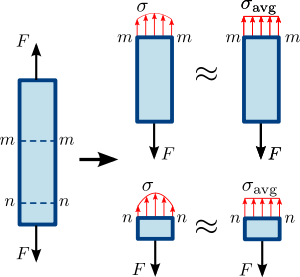Principle of St. Venant
The principle of Saint-Venant (after Adhémar Jean Claude Barré de Saint-Venant ) represents a simplification for the strength calculation of components. It states that at points where a force is applied, local irregular stress distributions can be neglected for the calculation. because they fade away very quickly.
Full formulation:
If the force acting on a small part of the surface of an elastic body is replaced by an equivalent system of forces , this load redistribution causes significant changes only in the local stresses: but not in areas that are large compared to the loaded surface.
For this reason, in a tension rod in the tensile test , the elongation measured only in the central region, since the cross-sectional area there is a constant voltage. The tension optics give a clear picture of this.
In practical strength theory , only those areas of a component are calculated where no external forces are effective.
The principle of Saint-Venant becomes more quantifiable through considerations of Stepan Tymoshenko . For example, in the case of a bending beam, a decay length can be defined for the stresses that roughly corresponds to the beam diameter.
